Our 19th annual tour to Fraser Island in search of tailor left us thinking about what we could do differently the following year. Targeting tailor with new techniques, methods or lures is all part of the equation. After all, if we all keep doing the same thing, where is the challenge and what could we be missing?
Considering our 10-day trip covered peak tailor periods (before and after the new moon) we expected high numbers of tailor. However, we were greeted by reports of dreaded ‘snot’ weed and a forecast of very few, if any tailor. So, on our first night after unloading our gear at the rental house, we rigged up and went chasing tailor with an attitude that reflected our predictions – not so optimistic!
After some trial and error with a couple of casts from gutter to gutter we eventually found a steeply shelving gutter with an entry and exit point, a nice foam cover coming off the back bank and a high sand dune behind us for the ‘shadow effect’ on the water that brings the fish on earlier. First cast, bang – the tailor were on for the fight! Six of us ended up with a few fish that night and in fact, despite their numbers being a little thin, every session we chased tailor during the trip was successful, especially on the western side.
We discovered that tough calls are sometimes required to find the tailor. If you turn up to a nice looking gutter but there are no fish, think about how the classic Clash song goes: “Should I stay or should I go?” If there are no fish in a few casts, or within five minutes, particularly when you’re fishing in the peak zone between 4:30-6pm in late winter or early spring, it’s time to call it and go!
This rule paid dividends on our trip. Once we found fish, I very quickly cut up some older pilchards and berleyed the gutter to keep the fish in the hole or gutter and feeding. This technique seemed to work well, because when filleting we often found the smaller bits of berley in the tailor’s stomachs.
A mistake anglers can make is to return to the same gutter day after day even as the tides change throughout the week. We found during our 10 days we had to change gutters after a couple of days, or even a day as either the fish weren't there or the formations were such that there wasn’t enough water in the gutters around the peak fishing times.
The other choice we were faced with during our stay was whether to bait fish or throw lures. It is actually good to have guys trying both methods to establish what will work best at the time.
Without a doubt, casting and slow retrieving ganged pilchard baits is a very productive method to catch tailor. However, at times strong sideways sweep mid-tide can play havoc with this technique, particularly if you are in a picket line of anglers. This can lead to tangles, the occasional loss of patience, and some grumpy anglers. Worse still, your bait very quickly ends up pushed to the side and out of the strike zone.
One way to deal with strong sweep is to use a star sinker on a paternoster rig to hold you out in the strike zone. Admittedly, if other anglers are still casting and retrieving aimlessly in the sweep they will get tangled with you, but an unwritten rule is to keep your line at 90° to you to avoid these tangles. Generally, you’ll be much better off if you find our own gutters, unless the fish are concentrated to only a few gutters. This will give you more room to fish and use such rigs to full effect.
I like to run three droppers off the star sinker rig I use, with each dropper about 10cm long. On the bottom dropper I attach a set of pre-made Tru-Turn gang hooks baited up with a traditional pilchard. We only use IQF (individually quick frozen) pilchards, and not in the block form. IQF pilchards are much easier to thaw and use – you just grab them one at a time instead of struggling to deconstruct a jigsaw of moulded frozen fish, often breaking them in the process. The IQFs cost marginally more but are worth every cent.
Back to the gang hooks, myself and my ‘Ontour Fishing Australia’ buddies use Tru-Turn gangs for all our tailor baitfishing. See the fact box for some of the many advantages of these great ganged rigs.
On the top two droppers of the star sinker rig I run a combination of a small surf popper on a 2/0 or 3/0 hook and a surf fly on a 3/0 hook. If one proves to be more successful on the day I’ll switch to two of the same, such as two surf poppers. Pink, green, and blue have been the best colours for me. Elkat Fishing Australia sell a range of surf flies for these purposes but are also great for reef and pelagic fishing. Surf poppers are available at some of the larger or speciality tackle stores.
What I like about these rigs is that apart from your bait being held firmly in place in heavy swell, you get two more bites at the cherry if a fish hits your bait and you miss it. Leave your rig there for a minute or two after it does, as often tailor will come back and hit the fly or popper straight after. With the fly and popper drifting around enticingly above the bait, it’s not unusual to find the artificials get hit before the bait.
Be patient when you hook up and keep the tip of the rod up high to maintain pressure on the hooked fish. The commotion from the hooked fish causes other tailor to become interested in the other droppers, and this can lead to a double or even the occasional triple hook-up! Two to three tailor kicking and bucking in different directions is a real challenge and lots of fun!
Interestingly, these rigs are much more popular on the NSW south coast where the beaches are more exposed to big southerly swells, but QFM readers should give them a go. They work, and are a change from the ‘same old, same old.’
When the tailor action is hot, the last thing you want to do is fiddle around in the back of the 4WD making new rigs if you lose one. For this reason you should make yourself up six or more rigs with different weight sinkers, or have a supply of snap-on Klik sinkers in weights from 5-9 on hand to attach to your rigs.
Rigs can then be carefully coiled up in small snap-lock bags with the gang hooks folded over each other and kept in alfoil to stop them tangling up the rig. I then mark the bags with permanent pen indicating the size sinker and fluorocarbon trace strength (normally 30-50lb).
Another trick for rigs to be used on Alvey reels is to run a soft bead between the sinker and the bottom swivel to help prevent knot breakage from the pressure of the sinker on the knot, particularly after a few casts. For night fishing you can also add a fluorescent glow bead or tubing above the gang hooks and charge these up with a headlamp (keeping the light off the water in the gutter while you do). This is an added attractant for the fish.
Once I have my rigs made up in snap lock bags, I carry three or four of them in an Alvey dry pack on my bait belt. With this and a pair of line cutters attached to the bait belt or in one of the Velcro straps on my Alvey Deluxe shoulder bag, I am ready to re-rig right there at the water’s edge in a flash and get my line back in the water.
I've used a number of metal lures over the years at Fraser but none of them have been as effective as the casting lures we’ve used in the last couple of years. These dynamite lures are called Adagio Duel and come in two sizes, 105 (about 30g) and 125 (about 45g). Even though the tailor were thin in numbers at Fraser this year, we found that if there were fish about, they took an Adagio. These lures regularly out-fished both bait and other lures fished side by side in the gutter.
The Adagio has a number of advantages over a metal lure, including the fact that you can work them at a slower medium pace with a swimming action, which makes mulloway another possibility when targeting tailor. Their sleek design means they have an outstanding casting distance, and the fact that they have three flat flashing sides means they tend to bring fish in from all directions. Interestingly, they also seem to attract larger fish from the school compared to those being caught by bait fishers. The other advantage is that when you’re not chasing tailor, the Adagio Duel can also be worked in a jig style for species such as snapper.
There are some other notable lures on the market that are worth a try for tailor when the action is hot. These include Engulf and Tamban jigs in 30-55g, which can be worked through the gutter like a flathead soft plastic jig. Lift the jig up with two or three hops using your wrist, and then let them flutter down naturally. Their sleek design also allows them to be worked at a fairly quick pace like a metal. Mix it up with pauses to allow a natural flutter every now and then like a wounded baitfish. You can experiment with stinger hooks on these jigs – try two on the rear, or two on the rear and 1 on the nose for slower lift-and-drop type actions. Again, when not using them for tailor, these are brilliant for snapper and reef fish with a lift-and-drop technique.
Another lure we don't see other anglers use much off the beach is the popper. Find the right gutter, i.e. one that has a back bank pushing white water over a deep gutter close to shore without too much choppy wave action, and you have the ingredients for a good gutter to throw poppers. Poppers such as the Lively Lures (makers of the legendary Micro Mullet) range of new pencil poppers have the added advantage of visibility; with quality sunglasses you can see the fish hit the lure on the surface.
Graphite rods are not only lightweight and easy to use for beach lure fishing, but they give you a direct feel for any hits on the lure. I love my Lox Iridium Surf in 12ft as it still gives me fantastic casting distance on the Adagios and poppers. I like to run 14-15lb braid (such as Platypus Platinum+) plus a 2.5m leader of fluorocarbon in about 20lb. You also don't need anything more than a 2000 to 2500 reel for comfort and balance on your graphite rod.
When you get a hit on your graphite rod, make sure you lift and wind, not strike, keeping constant pressure on the fish, then use a sideways sweep of the rod washing the fish up the beach from the last wave. Avoid deadlifting the fish into your arms or you risk breaking the tip.
I hope these experimental tips, rigs and lures encourage you to mix up your tailor fishing off the beach. After all, testing our skills is what angling is all about. For more tips, reports and locations jump on my Facebook page, Ontour Fishing Australia. And until next time, bag your mates – not your limit!
Reads: 6006
Sometimes tailor can take more interest in a surf popper than a pilchard!

Once again in 2015, the pink Adagio Duel 125 was the best performer out of all of our lures.
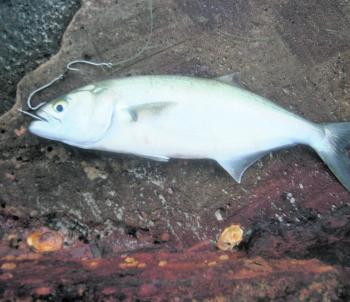
An average size tailor on the Tru-Turn gang hooks.

An assortment of Elkat Fishing Australia flies.
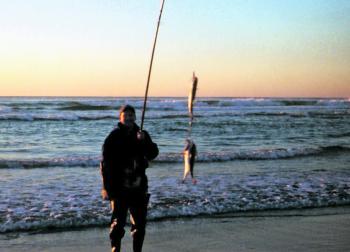
A triple hook-up on the star sinker rig on a previous Fraser tour.
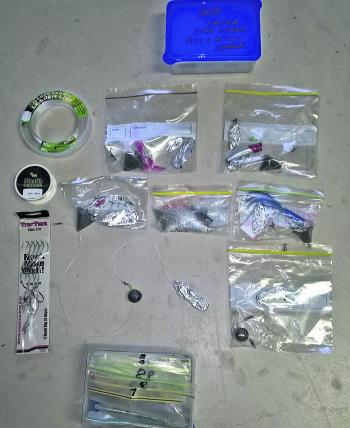
Pre-prepared tailor rigs, in marked snap-lock bags ready to go.
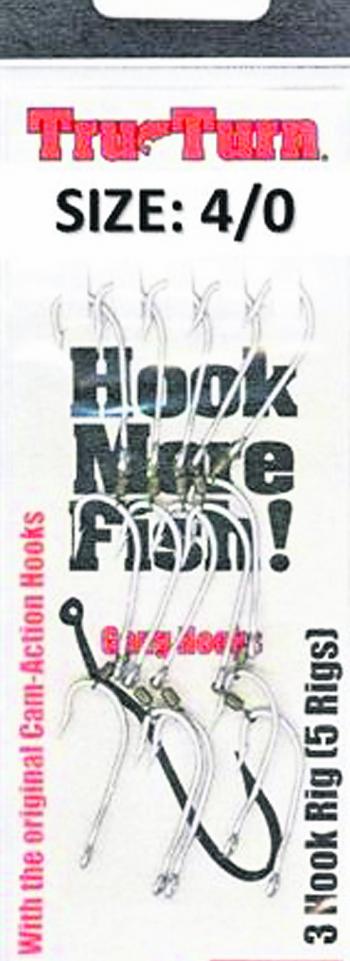
Pre-made Tru-Turn gang hooks can be purchased in packs of four, and are all ready to go!

A couple of hungry tailor both wanted this Adagio Duel lure!
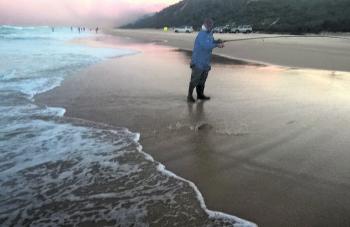
Rossco using a sideways sweep of his graphite rod to land another tailor on an Adagio.

An assortment of excellent tailor lures including Adagios, Engulf, and Tamban jigs and Lively Lures pencil poppers.




